When Ireland first beat the English at cricket
Published in 18th–19th - Century History, Features, Issue 5 (Sept/Oct 2011), Volume 19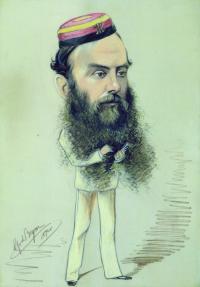
R.A. Fitzgerald—the only Irish player to reach double figures was their English-based captain, ‘who played in quite his old form’. (MCC/Bridgeman Art Library)
The first celebrated victory of the ‘Gentlemen of Ireland’ over the English at cricket was in a match played on Monday and Tuesday 26–27 May 1862 at Lord’s, the headquarters of the MCC and universally known as the home of cricket. Because the opposition was an ‘MCC Club and Ground’ team it cannot be considered a full international fixture, but it was significant because it was the first match played in London involving a representative Irish team. At the time, the strongest cricket clubs in Ireland were the Phoenix and the Leinster. In 1860 the Phoenix professional Charles Lawrence had organised a ‘United Eleven of Ireland’, which played matches in Belfast and Scotland, but in 1861 he took up an appointment in Australia.
The players
Ireland had previously hosted touring All-England Elevens, composed of professionals, who sometimes played against 16-man or 22-man Irish teams, but on this occasion the countries would meet on level terms, and in England. ‘Some of the best players in the sister isle will appear for the first time on the London turf’, reported the Sunday sporting newspaper Bell’s Life in London in its preview article, mentioning also that two of Ireland’s best players, Brennan and T. Quinn, were unable to make the journey. The Irish captain was the Hon. S. Ponsonby (1824–1915), later known as Sir Spencer Ponsonby-Fané. (His elder brother, Frederick, also an MCC member, became the sixth earl of Bessborough and chairman of Gladstone’s Land Commission.) An MCC professional, Jimmy Grundy, was loaned to them to compensate for the absence of Lawrence.
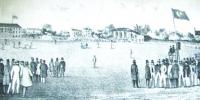
A mid-nineteenth-century cricket match at Lord’s, headquarters of the MCC and universally known as the home of cricket, where the match against the ‘gentlemen of Ireland’ was played on 26–27 May 1862.
George Frith Barry, who opened both the batting and the bowling, captained Irish teams on several occasions and was also one of the best chess-players in Ireland. He had made his debut for Leinster Cricket Club towards the end of 1853, its second season, when he was at most seventeen years old. By 1856 he was club captain and remained so until 1890, the year before he died. He and his elder brother Sam, who performed well in the field at Lord’s, played for the Victoria Chess Club in two telegraph matches against Belfast in 1861–2 and against the St James’s Club of London in 1865. Another notable member of the team was Hone, who had first played for the All-Ireland XI in 1861 when still a schoolboy. He later became known as William Hone senior because many members of that family distinguished themselves, one writing a history of Irish cricket in the 1950s.The English team consisted of ten amateurs and a professional left-arm bowler named Wooton. Reports do not say who was their captain. A few days before, both Grundy and Wooton had played successfully for the MCC in an away match against Oxford University. The umpires at Lord’s were stated by the Irish Times to be Messrs Royston and Barker (or ‘Baker’, according to the Times).
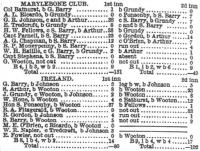
Scorecard of the match from Bell’s Life in London, 1 June 1862.
Day one of the match
The home team batted first. ‘The fielding on the part of Erin was, owing to the lively state of the ground, not so brilliant as it might have been; but the bowling of the Messrs Barry and of the traitor Grundy was well on the spot.’ Those bowlers each had an early success, dismissing the English opening pair for only one and a duck respectively. Most of the MCC’s runs came in a fourth-wicket stand between Fellows, ‘who arrived at 38 by some fine hitting’, and the more elegant Johnson, which was finally broken by ‘the early Celtish bowling’ of ‘S. Arthur’. He was Arthur Samuels, later a councillor in Kingstown township (now Dún Laoghaire), whose name appears there on the foundation plaque of the People’s Park. Captain Parnell, perhaps a cousin of the Avondale family, also batted ‘very steadily’ for the MCC.They finally made 131, a potentially match-winning total for those days. When Ireland batted, they struggled against Wooton and Johnson. The only man to reach double figures was their English-based captain, R.A. Fitzgerald, ‘who played in quite his old form’ before he was dismissed by a ball from Wooton ‘which sent the off bail flying to a distance of 39 yards behind the wickets’. Bowled out for 80, Ireland conceded a first innings lead of 51. Their fielding in the second innings was much improved: ‘the sons of Erin were going at it heart and sowl’ [sic], said Bell’s Life. The scorecard shows that they conceded far fewer extras than the English: one reason why they won. Six MCC wickets went down before the close of play.
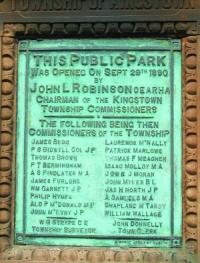
Arthur Samuels, whose ‘early Celtish bowling’ contributed to the Irish victory, later became a councillor in Kingstown (now Dún Laoghaire). His name appears on the foundation plaque of the People’s Park. (Tim Harding)
Day two
Heavy rain fell on Tuesday morning, delaying the start until 12.30. In those days wickets were left uncovered, which greatly favoured the bowlers. On resumption, one MCC player was absent while ‘Mr Arthur, a slow underhand bowler, was very deadly on the half-sodden ground’. The English were dismissed for 49, leaving Ireland set 101 to win. This was no simple task under the conditions, especially as they quickly lost both George Barry (unusually, for those days, dismissed leg before wicket) and Grundy—and also Fowler, who apparently batted out of order, probably because he had to leave early. Fitzgerald—who became secretary of the MCC the following year—redeemed his first innings failure, providing the backbone in the run-chase. The result was briefly reported in several papers, with the scorecard printed in both the London Times and the Irish Times, but the most detailed and colourful account appeared in Bell’s Life. Its reporter said that the outcome astonished many spectators:
‘We never saw a more gallant struggle, and the injuries of several hundred years of oppression and wrong are now indelibly wiped out, principally by Mr F-G, who carried his bat out for 33, including a sixer to leg, and Messrs Hone and Arthur, who both played admirably for their respective scores.’The result was fair, not least because Ireland did not rely as much as the MCC on their professionals for taking wickets. A few days after the Lord’s match, eight of the Irish team (minus Fitzgerald and Grundy), together with three scratch recruits, played Wimbledon. The Irish Times says that the Irish lost by one run. Samuels, one of the main contributors to the Lord’s victory, gave a talk on early cricket in Ireland which was published as a booklet in 1888. He described the match on Wimbledon Common in detail and says that it was tied. With scores level and the last man in,
‘. . . all the fielders were now brought round the wicket; the excitement was at white heat, the ladies in their carriages standing up, shouting, and waving their handkerchiefs. The fatal ball was bowled, and our last man’s wicket taken, during the greatest excitement I ever witnessed or experienced; and thus ended a match which, I feel certain, will never be erased from the memory of any who witnessed it.’
In his 40 years on the cricket-field, Samuels said,
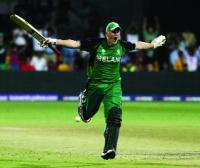
Kevin O’Brien, having just scored the fastest-ever century in World Cup cricket, celebrates Ireland’s stunning three-wicket win over England in Bangalore on 2 March 2011.
‘I never knew a good, or even an average, cricketer addicted to drink or any other lowering vice. A cricketer must have all his nerves and wits about him . . . Cricket teaches us a useful lesson in this life—that those we looked on as our inferiors are and may be, in many respects, our superiors.’ Just as Kevin O’Brien proved to the English on 2 March 2011! HI
Tim Harding’s Correspondence Chess in Britain and Ireland 1824–1987 was published this year by McFarland.
Further reading:
T. Harding, ‘George Frith Barry and the growth of chess in Victorian Ireland’, http://www.chessmail.com/xtras/barry.html.W.P. Hone, Cricket in Ireland (Tralee, 1956).G. Siggins, Green days: cricket in Ireland 1792–2005 (Stroud, 2005).
















